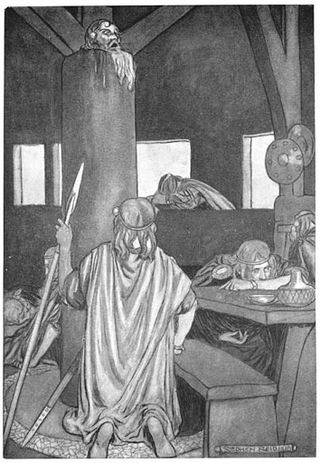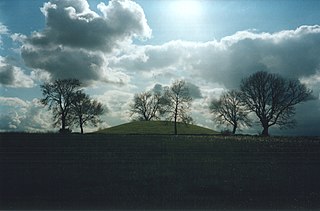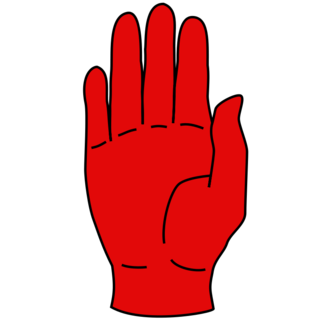Related Research Articles

Macha was a sovereignty goddess of ancient Ireland associated with the province of Ulster, particularly the sites of Navan Fort and Armagh, which are named after her. Several figures called Macha appear in Irish mythology and folklore, all believed to derive from the same goddess. She is said to be one of three sisters known as 'the three Morrígna'. Like other sovereignty goddesses, Macha is associated with the land, fertility, kingship, war and horses.
Conall Cernach is a hero of the Ulaid in the Ulster Cycle of Irish mythology. He had a crooked neck and is said to have always slept with the head of a Connachtman under his knee. His epithet is normally translated as "victorious" or "triumphant", although it is an obscure word, and some texts struggle to explain it. Alternative meanings include "angular, having corners", "swollen", or "possessing a dish or receptacle". The original form of the name "Conall" in Ogham inscriptions was Cunavalas.

Deirdre is a tragic heroine in the Ulster Cycle of Irish mythology. She is also known by the epithet "Deirdre of the Sorrows".
Conchobarmac Nessa is the king of Ulster in the Ulster Cycle of Irish mythology. He rules from Emain Macha. He is usually said to be the son of the High King Fachtna Fáthach, although in some stories his father is the druid Cathbad, and he is usually known by his matronymic, mac Nessa: his mother is Ness, daughter of Eochaid Sálbuide, King of Ulster.

Súaltammac Róich is the mortal father of the hero Cúchulainn in the Ulster Cycle of Irish mythology. His wife is Deichtine, sister of Conchobar mac Nessa, king of Ulster. His brother is Fergus mac Róich.

Fergus mac Róich/Róigh is an Irish hero and a character in the Ulster Cycle of Irish mythology. Formerly the king of Ulster, he is tricked out of the kingship and betrayed by Conchobar mac Nessa, becomes the ally and lover of Conchobar's enemy, queen Medb of Connacht, and joins her expedition against Ulster in the Táin Bó Cúailnge. Fergus is described as being of huge size and sexual potency. This leads him into many a precarious situation as in the story of the Táin Bó Flidhais.
The Red Branch is the name of two of the three royal houses of the king of Ulster, Conchobar mac Nessa, at his capital Emain Macha, in the Ulster Cycle of Irish mythology. In modern retellings it is sometimes used as the name of an order of warriors, the Red Branch Knights.
There are four provinces of Ireland: Connacht, Leinster, Munster and Ulster. The Irish word for this territorial division, cúige, meaning "fifth part", suggests that there were once five, and at times Meath has been considered to be the fifth province. In the medieval period, however, there were often more than five. The number of provinces and their delimitation fluctuated until 1610, when they were permanently set by the English administration of James I. The provinces of Ireland no longer serve administrative or political purposes but function as historical and cultural entities.

In Irish mythology, Naisi, Noíse or Noisiu was the nephew of King Conchobar mac Nessa of Ulster, and a son of Uisneach. He is mentioned in the tale known as the Tragic Tale of the Sons of Uisnech, or Exiles of the Sons of Uisnech, usually found within the set of stories in the Táin Bó Cúailnge, part of the Ulster Cycle.

The Ulster Cycle, formerly known as the Red Branch Cycle, is a body of medieval Irish heroic legends and sagas of the Ulaid. It is set far in the past, in what is now eastern Ulster and northern Leinster, particularly counties Armagh, Down and Louth. It focuses on the mythical Ulster king Conchobar mac Nessa and his court at Emain Macha, the hero Cú Chulainn, and their conflict with the Connachta and queen Medb. The longest and most important tale is the epic Táin Bó Cúailnge. The Ulster Cycle is one of the four 'cycles' of Irish mythology and legend, along with the Mythological Cycle, the Fianna Cycle and the Kings' Cycle.

Ulaid or Ulaidh was a Gaelic over-kingdom in north-eastern Ireland during the Middle Ages made up of a confederation of dynastic groups. Alternative names include Ulidia, which is the Latin form of Ulaid, and in Cóiced, Irish for 'the Fifth'. The king of Ulaid was called the rí Ulad or rí in Chóicid.

Navan Fort is an ancient ceremonial monument near Armagh, Northern Ireland. According to tradition it was one of the great royal sites of pre-Christian Gaelic Ireland and the capital of the Ulaidh. It is a large circular hilltop enclosure—marked by a bank and ditch—inside which is a circular mound and the remains of a ring barrow. Archeological investigations show that there were once buildings on the site, including a huge roundhouse-like structure that has been likened to a temple. In a ritual act, this timber structure was filled with stones, deliberately burnt down and then covered with earth to create the mound which stands today. It is believed that Navan was a pagan ceremonial site and was regarded as a sacred space. It features prominently in Irish mythology, especially in the tales of the Ulster Cycle. According to the Oxford Dictionary of Celtic Mythology, "the [Eamhain Mhacha] of myth and legend is a far grander and mysterious place than archeological excavation supports".

The Connachta are a group of medieval Irish dynasties who claimed descent from the legendary High King Conn Cétchathach. The modern western province of Connacht takes its name from them, although the territories of the Connachta also included at various times parts of southern and western Ulster and northern Leinster. Their traditional capital was Cruachan.

Dál Fiatach was a Gaelic dynastic-grouping and the name of their territory in the north-east of Ireland, which lasted throughout the Middle Ages until their demise in the 13th century at the hands of Normans. It was part of the over-kingdom of Ulaid, and they were its main ruling dynasty for most of Ulaid's history. Their territory lay in eastern County Down. Their capital was Dún Lethglaise (Downpatrick) and from the 9th century their main religious site was Bangor Abbey.

The Red Hand of Ulster is a symbol used in heraldry to denote the Irish province of Ulster and the Northern Uí Néill in particular. It has also been used however by other Irish clans across the island, including the ruling families of western Connacht and the chiefs of the Midlands.
The Three Collas were, according to medieval Irish legend and historical tradition, the fourth-century sons of Eochaid Doimlén, son of Cairbre Lifechair. Their names were: Cairell Colla Uais; Muiredach Colla Fo Chrí ; and Áed Colla Menn. Colla Uais ruled as High King of Ireland for four years. Recent DNA analysis confirms the history of the Three Collas in fourth-century Ireland, but questions their descent from Eochaid Doimlén and Cairbre Lifechair.
Rudraige mac Sithrigi, was, according to medieval Irish legend and historical tradition, a High King of Ireland. The son of Sitric, he took power after killing his predecessor, Crimthann Coscrach, and ruled for thirty or seventy years, after which he died of plague in Airgetglenn. He was succeeded by Finnat Már, son of Nia Segamain. He is the ancestor of Clanna Rudraige.
Scéla Conchobair maic Nessa or the Tidings of Conchobar mac Nessa is a title invented by Whitley Stokes for a short prose piece from the Ulster Cycle preserved in the 12th-century manuscript, the Book of Leinster. It is interpolated with lore not found elsewhere regarding the branches (halls) of the Ulster court at Emain Macha and the shields of the Ulstermen.
References
- ↑ Gantz, Jeffrey (1981). Early Irish Myths and Sagas. ISBN 9780140443974 . Retrieved 5 July 2016.
- ↑ Oosten, Jarich (5 March 2015). The War of the Gods (RLE Myth): The Social Code in Indo-European Mythology. ISBN 9781317555841 . Retrieved 5 July 2016.
- ↑ Whitley Stokes (ed. & trans.), "Tidings of Conchobar mac Nessa", Ériu 4, 1910, pp. 18-38
- ↑ Gregory, Lady (21 March 2001). Cuchulain of Muirthemne: The Story of the Men of the Red Branch of Ulster. ISBN 9780486417172 . Retrieved 5 July 2016.
- ↑ Joyce, P.W. "A Smaller Social History of Ancient Ireland" . Retrieved 5 July 2016.
- ↑ Price, Glanville. The Celtic Connection. Rowman & Littlefield, 1992. p.73
- 1 2 3 MacGeoghan, Abbe (1844). "The History of Ireland, Ancient and Modern" . Retrieved 4 July 2016.